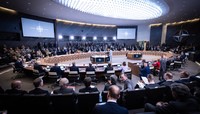NATO Secretary General Jens Stoltenberg recently released the organization’s annual status report
We present his summary:
Russia’s war of aggression against Ukraine rages on, there is a new war in the Middle East, and Allies face greater competition from authoritarian states, including China. In addition, we still face a range of other threats to our security, including terrorism, cyber attacks and climate change. The world has become more dangerous, but NATO is stronger.
In 2023, NATO grew bigger and more capable. Finland became a NATO Ally, and we have just welcomed Sweden as well. We continued to strengthen our defences. At our Summit in Vilnius, we agreed robust new plans to defend every inch of Alliance territory. These plans are backed by hundreds of thousands of troops and highly capable air and naval forces at a high state of readiness – and with eight battlegroups on our eastern flank, stretching from the Baltic to the Mediterranean Sea, scalable to brigade size.
In 2023, defence spending increased by an unprecedented 11% across Europe and Canada. Since we agreed the Defence Investment Pledge in 2014, European Allies and Canada will have spent more than USD 600 billion extra on defence. In 2024, we expect two-thirds of Allies to meet or exceed the target of investing 2% of Gross Domestic Product in defence. At the Vilnius Summit, we agreed the Defence Production Action Plan, to ramp up production and replenish our stocks of weapons and ammunition. Billions of dollars of contracts have already been signed with defence industry. This will mean more security for Allies, more supplies for Ukraine, and more highly skilled jobs across Europe and North America.
In addition to strengthening our own collective defence, NATO continues to support Ukraine. Ukraine must prevail as an independent, sovereign nation. If Putin wins, this would send a dangerous message to authoritarian leaders around the world that they can achieve their objectives through war and violence. Supporting Ukraine is not charity, it is in our own security interest.
At the Vilnius Summit, we brought Ukraine closer to NATO than ever before. We established the NATOUkraine Council where we meet to discuss and take decisions on our common security interests, as equals. We are helping to transition Ukraine from Soviet-era to NATO equipment and standards. We have also removed the requirement for a Membership Action Plan, significantly shortening Ukraine’s path to membership. All Allies agree that Ukraine will become a member of NATO.
China is watching our actions closely. China does not share our values, it challenges our interests, and Beijing is increasingly aligned with Moscow. We will continue to trade and engage with China, but we must manage the risks and prepare for enduring competition.
NATO is a regional alliance that faces global challenges, so our partnerships around the world are essential for our security. We continue to work closely with the European Union on a wide range of security issues. We are also deepening our cooperation with our partners in the Indo-Pacific – Australia, Japan, New Zealand and the Republic of Korea – and I have appointed a group of experts to review NATO’s approach to our southern neighbourhood.
2024 marks the 75th anniversary of the NATO Alliance. In all those years, the bond between Europe and North America has kept our nations secure and our people safe. At the Washington Summit in July, we will send a powerful message of unity, solidarity and resolve – to prevent war and preserve peace.
Shattered Peace: Responding to Russia’s Aggression
NATO tried to build a partnership with Russia for decades. Over the past decade, however, Russia has continuously violated the norms and principles that have contributed to a stable and predictable European security order. Russia’s brutal and illegal war of aggression against Ukraine, launched in February 2022, has shattered the hard-earned peace in Europe.
As NATO’s 2022 Strategic Concept makes clear, the Russian Federation is the most significant and direct threat to Allies’ security, and to peace and stability in the Euro-Atlantic area. Russia seeks to establish spheres of influence and direct control through coercion, subversion, aggression and annexation. It uses conventional, cyber and hybrid means against NATO and its partners. Its coercive military posture, rhetoric and proven willingness to use force to pursue its political goals undermine the rules-based international order. The Russian Federation is modernising its nuclear forces and expanding its novel and disruptive dual-capable delivery systems, while employing coercive nuclear signalling. It aims to destabilise countries to our East and South. In the High North, its capability to disrupt Allied reinforcements and freedom of navigation across the North Atlantic is a strategic challenge to the Alliance. Moscow’s military build-up, including in the Baltic, Black and Mediterranean Sea regions, along with its military integration with Belarus, challenge the Alliance’s security and interests.
In light of its hostile policies and actions, NATO cannot consider Russia to be a partner. Any change in the relationship depends on Russia halting its aggressive behaviour and fully complying with international law. NATO remains willing to keep open channels of communication with Moscow to manage and mitigate risks, prevent escalation and increase transparency. NATO does not seek confrontation and poses no threat to Russia.
At the Vilnius Summit in July, Allies agreed to continue to consult on and assess the implications of Russia’s policies and actions for Allied security, and respond to Russian threats and hostile actions in a united and responsible way.
Photo: Meeting of the North Atlantic Council in Foreign Ministers’ Session (NATO)
